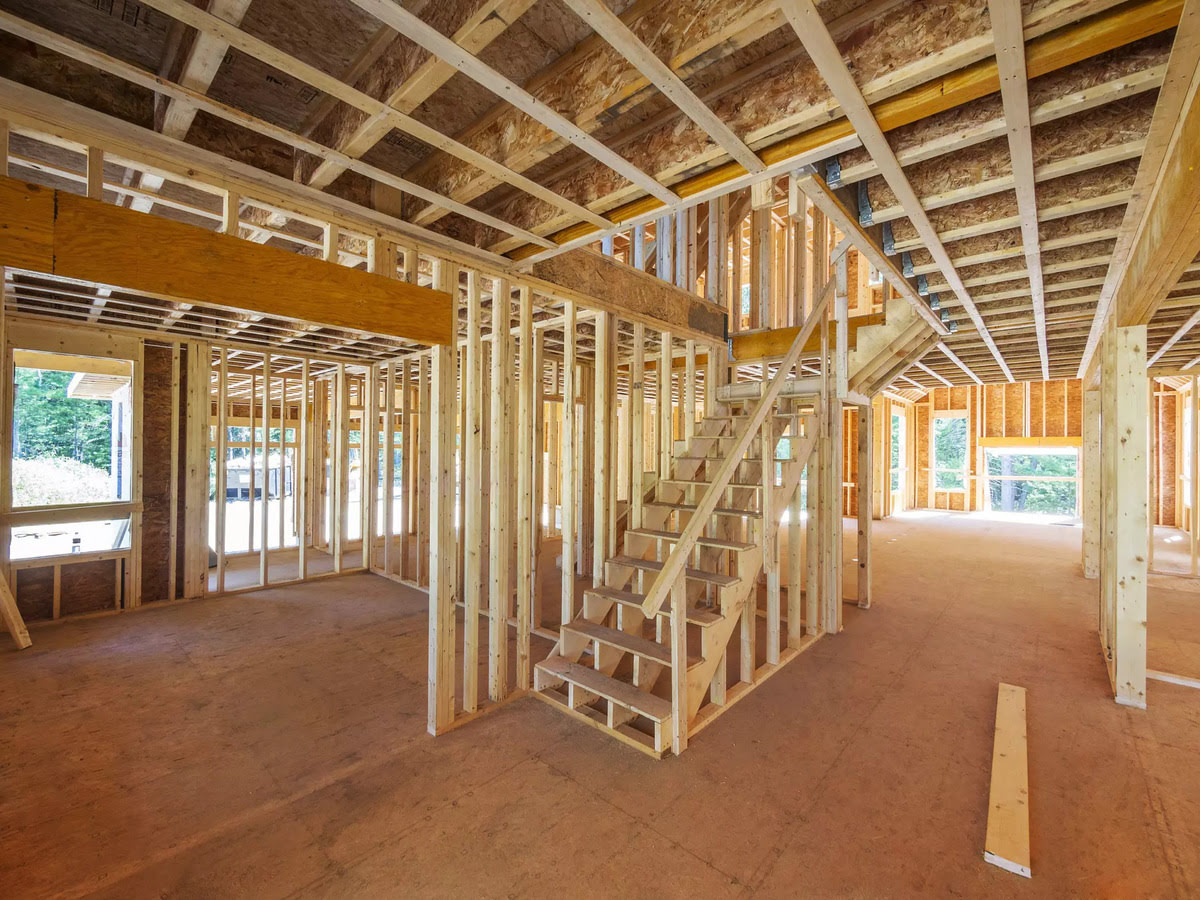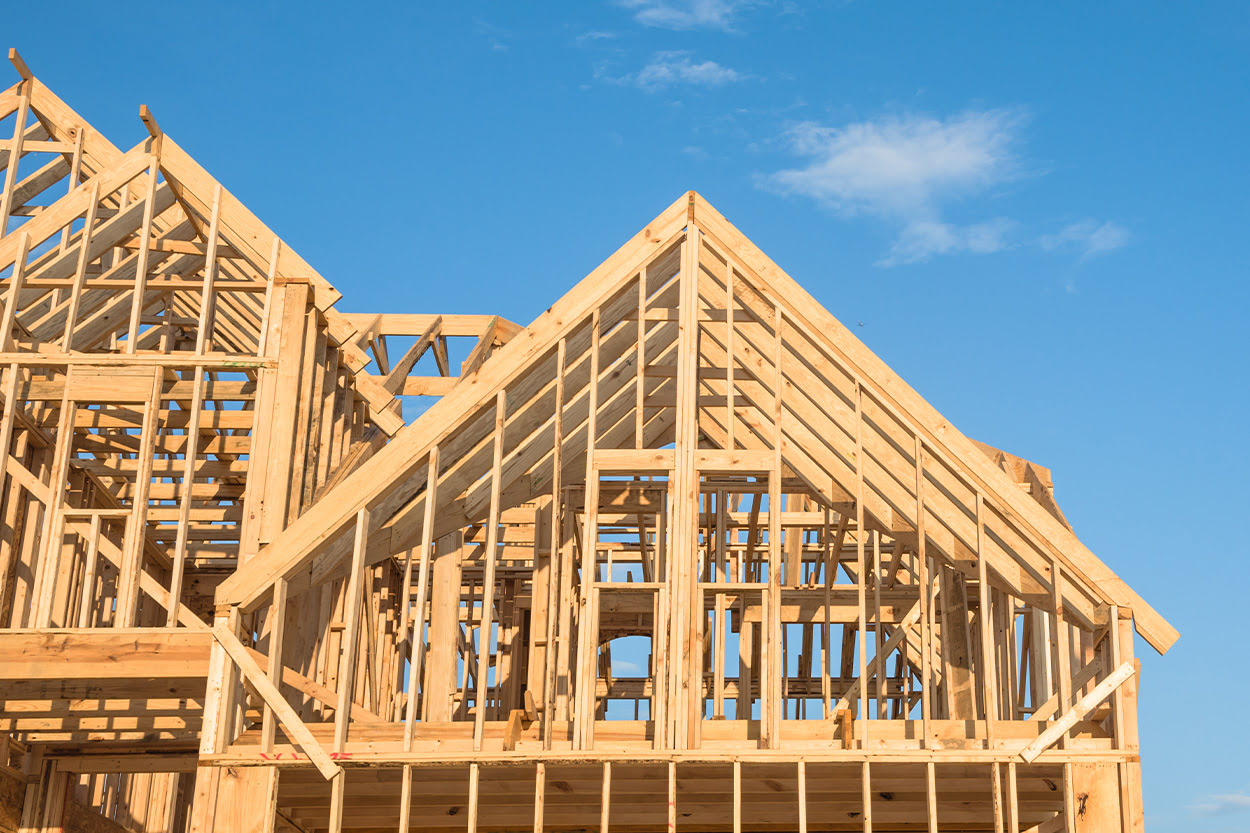Home>diy>Building & Construction>When Is A Remodel Considered New Construction


Building & Construction
When Is A Remodel Considered New Construction
Modified: October 20, 2024
Learn the key differences between a remodel and new construction, and understand when a renovation project falls under the category of building construction.
(Many of the links in this article redirect to a specific reviewed product. Your purchase of these products through affiliate links helps to generate commission for Storables.com, at no extra cost. Learn more)
Introduction
When it comes to the world of construction, there are different terms that are used to describe the various processes involved in creating or renovating a building. Two common terms that often come up are “remodel” and “new construction.” Understanding the difference between these two concepts is crucial, as it can have significant implications on several factors, such as legal requirements, cost considerations, and even tax implications. In this article, we will explore the definitions of remodel and new construction, as well as the factors to consider when determining which category a construction project falls under.
Before delving into the specifics, it’s important to first define the terms “remodel” and “new construction.” A remodel refers to the process of modifying or renovating an existing structure. This typically involves making changes to the interior or exterior of the building, such as updating the layout, adding new features, or improving the overall functionality. On the other hand, new construction refers to the construction of an entirely new building from scratch, starting with an empty lot or a cleared site.
So, what factors should be taken into account when determining whether a project is a remodel or new construction? Let’s explore.
Key Takeaways:
- Understanding the difference between remodel and new construction is crucial for legal compliance, cost-effective planning, and securing the right permits and insurance coverage for a successful building project.
- Carefully evaluating the scope of work, cost implications, financing options, insurance considerations, and tax implications is essential for informed decision-making and successful execution of construction projects.
Definition of Remodel and New Construction
Understanding the difference between a remodel and new construction is essential for anyone involved in the building industry. These terms describe two distinct processes, each with its own set of characteristics and requirements.
A remodel is a renovation or alteration of an existing building. It involves making changes to the structure, layout, or design of a building, without demolishing and starting from scratch. Remodeling can range from minor changes, such as updating fixtures or repainting walls, to more extensive renovations, such as adding new rooms or expanding the overall floor area.
On the other hand, new construction refers to the construction of a completely new building. This involves starting from an empty lot or demolishing an existing structure to build a brand-new one. New construction projects typically involve a complete design and construction process, including architectural planning, engineering, and building from the ground up.
The key distinction between a remodel and new construction is the starting point of the project. Remodeling focuses on improving an existing building, while new construction starts from scratch.
There are a few factors that can help determine whether a project should be classified as a remodel or new construction:
- Scope of work: The extent of the changes being made to the building is a significant factor. If the majority of the building remains intact, with only minor modifications or enhancements, it is likely a remodel. However, if the project involves significant demolition and construction of new components, it would be classified as new construction.
- Building permits and codes: Local building codes and permit regulations may have specific criteria for distinguishing between remodels and new construction. It is essential to consult these requirements to ensure compliance.
- Cost implications: Remodeling projects tend to be more cost-effective compared to new construction, as the existing infrastructure can be utilized and modified. New construction projects, on the other hand, often require higher costs for materials, labor, and building from the ground up.
- Insurance considerations: Insurance coverage for remodels and new construction may differ. It is important to understand the insurance requirements and potential implications based on the classification of the project.
By considering these factors, it becomes easier to determine whether a project is a remodel or new construction. This clarity is essential for carrying out the project efficiently and ensuring compliance with legal and financial requirements.
Factors to Consider
When determining whether a construction project falls under the category of a remodel or new construction, several factors need to be considered. These factors can help guide decisions and ensure appropriate planning and execution of the project.
1. Scope of Work: One of the key factors to consider is the scope of work involved. Evaluate the extent of the changes being made to the existing building. If the modifications are minimal and focused on improving specific areas, it is likely a remodel. However, if the project involves extensive demolition or building from scratch, it would be classified as new construction.
2. Building Permits and Codes: Check local building codes and permit requirements to understand the criteria used to distinguish between remodels and new construction. These regulations may have specific guidelines based on the scope of work, such as the percentage of the building being modified or the addition of square footage. Compliance with these regulations is essential for avoiding legal issues and ensuring the safety and integrity of the structure.
3. Cost Implications: Consider the financial aspect of the project. Remodeling projects tend to be more cost-effective compared to new construction, as existing infrastructure can often be repurposed and modified. However, if the project requires significant demolition or structural changes, new construction costs may be more appropriate. Carefully assess the budget and allocate funds based on the scope of work and desired outcome.
4. Timeline and Resources: Evaluate the timeline and resources required for the project. Remodeling projects can often be completed faster since the existing structure is already in place. New construction projects, on the other hand, may require longer planning and construction timelines. Consider the availability of resources, including labor and materials, to ensure the project can be successfully executed within the desired timeframe.
5. Sustainability and Energy Efficiency: Consider the environmental impact of the project. Both remodels and new construction offer opportunities to implement sustainable and energy-efficient practices. Assess the potential for incorporating green building materials, renewable energy systems, and efficient HVAC systems to minimize the building’s carbon footprint and long-term operational costs.
By carefully considering these factors, stakeholders can make informed decisions on whether a construction project should be classified as a remodel or new construction. This clarity is crucial for effective planning, securing the necessary permits, allocating resources appropriately, and achieving the desired outcome.
Scope of Work
One of the primary factors to consider when determining whether a construction project falls under the category of remodel or new construction is the scope of work involved. The scope of work refers to the specific tasks and changes that will be undertaken as part of the project.
In a remodel, the scope of work typically involves making modifications or renovations to an existing building. This can include interior and exterior changes such as updating fixtures, replacing flooring, repainting walls, or reconfiguring the layout. Remodels can range from minor cosmetic upgrades to extensive renovations that involve structural changes or additions.
Conversely, in new construction projects, the scope of work is much broader. It includes all the tasks needed to build a new structure from the ground up. This encompasses various stages, such as site preparation, foundation construction, framing, installation of utilities and infrastructure, and finishing touches like flooring, painting, and landscaping.
When determining the scope of work, it is important to consider the extent of changes being made to the existing structure. If the project involves making minor enhancements or updates while preserving the majority of the building’s framework, it would likely be classified as a remodel. Examples could include adding a new bathroom, expanding a kitchen, or converting a basement into usable living space.
On the other hand, if the project involves significant demolition or requires constructing new components from scratch, it would be classified as new construction. For instance, building an entirely new wing or adding an additional floor to an existing building would fall under new construction due to the extensive changes to the structure.
It is crucial to accurately define the scope of work for a construction project, as it influences several aspects of the planning and execution process. The scope determines the required permits, materials, labor, and timeline needed for the project. Clear communication between project stakeholders is essential to ensure that everyone involved is aligned on the scope of work and understands the project’s objectives.
Additionally, accurately defining the scope of work helps in determining the project’s cost estimate. Remodels typically involve a narrower scope and may have less cost variability, while new construction projects tend to have a broader scope and may be subject to more cost uncertainties.
By carefully evaluating the scope of work, stakeholders can determine whether a construction project should fall under the category of a remodel or new construction. This clarity is crucial for effective project planning, resource allocation, and successful project execution.
Building Permits and Codes
Building permits and codes play a crucial role in determining whether a construction project is classified as a remodel or new construction. These regulations are put in place to ensure that buildings are constructed or modified in compliance with safety, zoning, and environmental standards. Understanding and adhering to these requirements is essential for a successful construction project.
When it comes to remodels, building permits and codes generally require compliance with specific criteria to distinguish the project from new construction. The criteria typically revolve around the extent of changes being made to the existing structure. For example, if the remodel involves purely cosmetic upgrades or minor interior modifications, it may not require a permit or be subject to rigorous code inspections. However, if the project involves structural changes, electrical or plumbing work, or additions that affect the overall square footage, a permit is likely necessary.
In contrast, new construction projects almost always require building permits. The permit process involves submitting detailed plans and specifications for review by local building authorities. The purpose is to ensure that the proposed construction meets all the necessary codes and regulations, including structural integrity, fire safety, accessibility, and energy efficiency standards.
Building codes vary by location and may have specific criteria for differentiating between remodels and new construction. For example, some jurisdictions may have a threshold percentage of the existing structure that can be modified before it is considered new construction. Others may determine classification based on the total square footage being added to the building. It’s important to consult local building authorities or engage an architect or contractor familiar with the specific codes and regulations of the area in question.
Obtaining the necessary building permits ensures that your construction project is legally authorized, and it helps protect against potential violations and penalties. It also ensures that the project follows the best practices and safety standards set forth by local authorities, reducing the risk of accidents and ensuring a safe and habitable structure.
It is important to note that failure to obtain the required permits can lead to significant consequences, including fines, legal liabilities, and potential delays in project completion. It can also impact the ability to sell or insure the property in the future.
In summary, building permits and codes are essential factors to consider when classifying a construction project as a remodel or new construction. Familiarize yourself with the regulations and requirements of your specific jurisdiction to ensure compliance and a successful project outcome.
When remodeling a property, it is considered new construction if the changes are extensive enough to essentially create a new structure. This can include adding new square footage, changing the layout, or significantly altering the existing structure. Always check local building codes and regulations to determine what qualifies as new construction in your area.
Read more: When Is HVAC Installed In New Construction
Cost Implications
One of the most significant factors to consider when determining whether a construction project falls under the category of a remodel or new construction is the cost implications. Cost plays a crucial role in decision-making and can have a significant impact on the feasibility and overall outcome of the project.
Remodeling projects tend to be more cost-effective compared to new construction. This is because remodels often involve working with existing infrastructure, which can reduce the need for extensive demolition and construction from scratch. By leveraging the existing structure, remodeling projects can save on material and labor costs.
In a remodel, the scope of work is generally focused on specific areas or rooms within the building. Costs can vary depending on the scale and complexity of the project. For example, a simple kitchen remodel, where the cabinets, countertops, and appliances are updated, will cost less compared to a full-scale renovation that includes relocating plumbing and electrical systems, replacing flooring, and reconfiguring the entire layout.
In contrast, new construction projects have different cost implications. New construction involves building from the ground up, which typically results in higher costs compared to remodeling. The project requires more materials, labor, and time to complete. Various factors influence the cost of new construction, including the size of the building, the complexity of the design, the quality of materials used, and the location of the construction site.
Additionally, new construction projects often involve additional expenses such as site preparation, foundation construction, and infrastructure installations, which are not typically required in a remodel. These considerations further contribute to the higher cost of new construction.
It’s important to establish a realistic budget based on the scope of work and desired outcome for the project. Consulting with professionals such as architects, contractors, or estimators can help provide accurate cost estimates for both remodeling and new construction projects.
Another factor to consider is the potential return on investment (ROI). Remodeling projects can yield a high ROI, particularly in areas such as kitchens and bathrooms, where upgrades and modernization can significantly increase property value. On the other hand, new construction projects may require a longer time to recoup the initial investment and may depend on various factors such as market conditions and location.
It is important to carefully evaluate the cost implications of a construction project and weigh them against the desired outcome, budget constraints, and potential return on investment. By considering the financial aspects, stakeholders can make informed decisions and allocate resources effectively to ensure the success of the project.
Financing Options
When considering a construction project, whether it is a remodel or new construction, financing plays a crucial role. It is essential to explore different financing options to determine the most suitable and feasible approach for funding the project.
1. Personal Savings: Using personal savings is a common financing option for smaller-scale remodeling projects. If you have sufficient funds set aside, using your own savings can provide the flexibility and control over the project without incurring any interest or debt. However, it is crucial to ensure that your savings will cover the entire cost of the project and leave you with enough financial cushion for unexpected expenses.
2. Home Equity Loans and Lines of Credit: For larger remodeling projects, tapping into your home’s equity can be a viable financing option. Home equity loans and lines of credit allow you to borrow against the value you have built in your home. These loans typically offer lower interest rates compared to personal loans or credit cards, making them a cost-effective way to finance your project. However, keep in mind that using your home as collateral means that you are putting it at risk if you are unable to make the loan payments.
3. Personal Loans: If you don’t have enough equity in your home or prefer not to use it as collateral, personal loans can be an alternative financing option. Personal loans are unsecured loans that can be used for various purposes, including financing home improvement projects. These loans usually have higher interest rates compared to home equity loans, but they provide flexibility and do not require collateral.
4. Construction Loans: In the case of new construction projects, where significant building and construction are involved, construction loans are a common financing option. These loans are specifically designed to provide funds for the construction phase and are typically interest-only during that period. Once construction is completed, the loan is converted into a traditional mortgage or paid off using other financing sources.
5. Government Programs and Grants: Depending on the nature and purpose of your construction project, there may be government programs or grants available to provide financial assistance. These programs vary by location and may have specific eligibility requirements. Research local government initiatives, subsidies, or grants that support home renovation or energy-efficient construction projects.
6. Contractor Financing: Some contractors may offer financing options directly for their services. This can be a convenient option, as it eliminates the need to apply for separate financing. However, be sure to carefully review the terms and interest rates offered by the contractor and compare them with other financing options to ensure you are getting favorable terms.
Before making a decision, thoroughly evaluate the terms and conditions, interest rates, repayment options, and eligibility requirements of each financing option. Consider your financial situation, the estimated project cost, and your long-term financial goals. It is advisable to consult with a financial advisor or loan officer to understand the implications of each financing choice and choose the option that aligns best with your needs.
Remember, regardless of the financing option chosen, it’s important to budget appropriately, track expenses, and ensure that the repayment plan is manageable within your financial capabilities.
Insurance Considerations
When undertaking a construction project, whether it’s a remodel or new construction, it is crucial to consider insurance implications. Insurance coverage protects you and your property from potential risks and provides financial security in the event of unforeseen events or accidents. Here are some insurance considerations to keep in mind:
1. Homeowners Insurance: As a homeowner, you likely already have homeowners insurance in place. However, it’s important to review your policy and inform your insurance provider about the construction project. The renovations or new construction may necessitate adjustments to your coverage or additional riders to protect the property and its value during the construction process.
2. Builder’s Risk Insurance: Builder’s risk insurance is designed specifically for construction projects. It provides coverage for property in the course of construction, protecting against risks such as damage or theft of materials, vandalism, and certain weather-related incidents. This insurance typically covers the structure itself, as well as materials, equipment, and fixtures on the construction site.
3. Liability Insurance: Liability insurance is essential for construction projects, as it protects against claims or lawsuits in case of injury or property damage during the construction process. It provides coverage for legal defense costs and potential settlements or judgments. Contractors typically carry liability insurance, but it is important to ensure that both you and your contractor have appropriate coverage to mitigate any liability risks.
4. Worker’s Compensation Insurance: If you are hiring workers or contractors for the construction project, it is crucial to verify that they have valid worker’s compensation insurance. Worker’s compensation provides coverage for medical expenses, lost wages, and rehabilitation costs for workers who are injured while working on your property. Ensuring that workers have this insurance protects you from potential liability claims if an accident occurs on the job site.
5. Additional Insurances: Depending on the nature of your construction project, there may be other additional insurances to consider. For example, if you are undertaking a major renovation that involves structural changes, you may need to consider additional coverage, such as flood insurance or earthquake insurance. These additional policies provide protection against specific risks that may not be covered under standard homeowners insurance.
It’s crucial to communicate with your insurance provider and discuss the details of your construction project. They can provide guidance on whether modifications to your existing policies are required or if additional insurance options need to be considered. Ensure that you have the necessary coverage in place before starting the construction project to avoid any gaps in protection.
Remember to keep records of the construction process, including photos, receipts, and documentation, as it may be required by your insurance provider in case of a claim. Preparing for unforeseen events and having the right insurance coverage in place will provide peace of mind and protect your investment throughout the construction process.
Tax Implications
Undertaking a construction project, whether it is a remodel or new construction, can have tax implications that should be carefully considered. Understanding these implications can help you make informed decisions and potentially take advantage of available tax benefits. Here are some key tax considerations to keep in mind:
1. Deductible Expenses: Depending on the nature and purpose of your construction project, certain expenses may be tax-deductible. For example, if you are remodeling a home office or adding energy-efficient features, you may be eligible for tax deductions or credits. It is important to consult with a tax professional or review tax guidelines to determine which expenses may be deductible.
2. Capital Gains Tax: If you plan to sell your property in the future, a construction project, whether it is a remodel or new construction, may have implications for capital gains tax. The cost of the construction project can be added to the property’s cost basis, potentially reducing the capital gains tax owed when selling the property. However, it is important to keep records of all construction-related expenses to accurately calculate the adjusted cost basis.
3. Property Tax: Construction projects can potentially impact your property tax assessment. Remodels and new construction may increase the assessed value of your property, which can lead to higher property tax obligations. It is advisable to consult with local tax authorities to understand how construction projects may affect your property taxes and plan accordingly.
4. Energy Efficiency Incentives: Many jurisdictions offer incentives and tax credits for incorporating energy-efficient features into your construction project. These incentives promote sustainable building practices and reduce the carbon footprint of buildings. Examples of energy-efficient features that may qualify for incentives include solar panels, energy-efficient HVAC systems, and insulation upgrades. Research local programs and consult with professionals to identify potential tax benefits related to energy efficiency.
5. Home Office Deduction: If part of your construction project involves creating or renovating a home office, you may be eligible for a home office deduction. This deduction allows you to deduct a portion of your home-related expenses, such as mortgage interest, property taxes, and utilities, based on the square footage of the home office. Be sure to familiarize yourself with the specific requirements and consult with a tax professional to ensure compliance.
6. State and Local Tax Variations: Tax laws and regulations vary by jurisdiction, so it is essential to be aware of any state or local tax variations that may apply to your construction project. Consult with tax professionals who are knowledgeable about the specific tax laws in your area to understand the implications and potential benefits specific to your location.
It is important to note that tax laws and regulations are subject to change, so staying informed and seeking professional advice is crucial when it comes to tax planning for your construction project. Each project is unique, and the specific tax implications will depend on factors such as the nature of the project, location, and individual circumstances. Consultation with a tax professional will help ensure that you are maximizing potential tax benefits and meeting all compliance requirements.
Conclusion
Understanding the distinction between a remodel and new construction is vital for anyone involved in the building industry, as it affects legal requirements, costs, financing, insurance, and tax implications. Remodeling involves making renovations or modifications to an existing structure, while new construction entails building from the ground up.
When determining whether a project falls under a remodel or new construction, several factors must be considered. The scope of work, building permits and codes, cost implications, financing options, insurance considerations, and tax implications are all crucial aspects to assess.
By carefully evaluating the scope of work, stakeholders can determine whether the project involves minimal changes to the existing building or requires extensive demolition and construction of new components. Understanding local building codes and permit regulations is essential to ensure compliance. Considering cost implications helps set realistic budgets and make informed decisions about financing options, such as personal savings, loans, or government programs.
Insurance considerations, including homeowners insurance, builder’s risk insurance, liability insurance, and worker’s compensation insurance, protect against potential risks and provide financial security. Understanding tax implications, such as deductible expenses, capital gains tax, property tax, energy efficiency incentives, and home office deductions, helps homeowners navigate the tax landscape effectively.
In conclusion, whether it is a remodel or new construction, proper planning, research, and consultation with professionals are essential for a successful construction project. Understanding the nuances and considerations discussed in this article will help ensure compliance, mitigate risks, and make informed decisions throughout the construction process, ultimately leading to a successful outcome.
Frequently Asked Questions about When Is A Remodel Considered New Construction
Was this page helpful?
At Storables.com, we guarantee accurate and reliable information. Our content, validated by Expert Board Contributors, is crafted following stringent Editorial Policies. We're committed to providing you with well-researched, expert-backed insights for all your informational needs.














0 thoughts on “When Is A Remodel Considered New Construction”